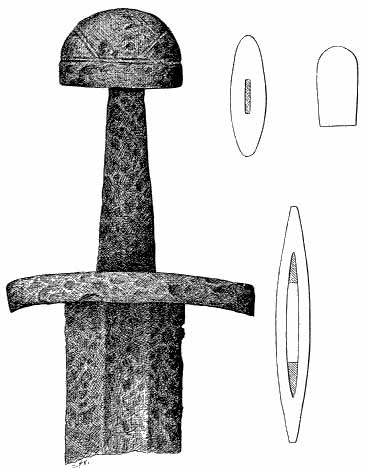 |
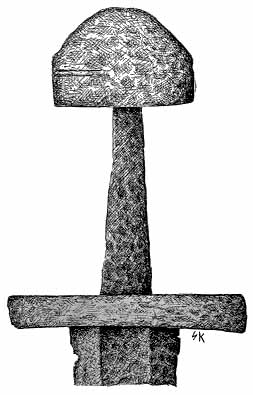 |
We shall now discuss two types, also of a plain nature, lacking in ornamentation. They exist in large numbers and, on the whole, give a familiar impression, [158] even if their origin is not to be found here [in Norway]. Contrary to types like B, C and F, these types belong to the late Viking Age, and they also represent a later period than type M, almost simultaneous with type Q, but preceding the last familiar type, type Æ.
 |
 |
We shall first consider type X. The upper hilt consists of only one piece, a pommel with almost half-circular sides, the cross-section is evenly wide and rounded at the corners. The type appears in two variants. The oldest has a taller and slimmer pommel (sl. fig.125-26 and R 501), while the lower guard is also taller and slightly curved as in type Q, which has been the prototype - again a new example of the blending of types, and as such a proof that they apparently existed close to the same time period. In sword C 280 (fig. 125), mentioned under the previous type, the wide side of the pommel is first divided in two [159] by a horizontal furrow, and furthermore the upper portion [of the pommel] is divided into three [sections]. Similar furrows that indicate a division between hilt and pommel are shown in C 5386 from Bryni in Romedal, Hedemark (fig. 126), and similarly in C 1604 from Aakeren in Laardal, Brb., where there are also remnants of a loose iron thread in the furrow. It is otherwise evident that the whole of type X came into being through a growing together of the [upper] guard and a [formerly] detached pommel. The prototype can be found in our material. Thus, we have such a sword in B 860-62 from Skeie, Vangen s. Voss, S. B. (fig. 128a) and C 5397 Vestum, Hedrum, J. L. Type N, which possibly could have been a model for type X, can also be grouped together with these specimens.
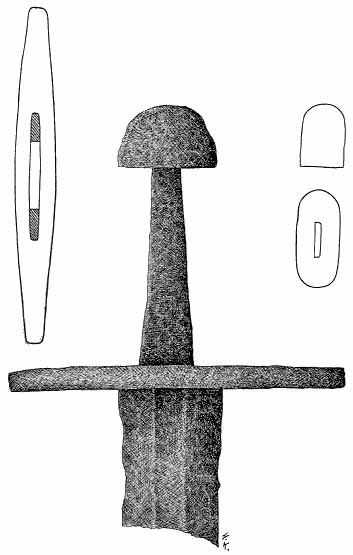
The later and most usual of the two variants (fig. 124 and R 509), has a lower, thicker and shorter pommel and a lower and wider lower guard that at times can reach a considerable length, but that can also be quite short as in type M for example. The cross-section of the hilt is here evenly wide, with rounded ends, and not cut sharply across, which is otherwise usual with type M. The first group has upper hilts [pommels] that can reach a length of 7.8 cm. and a height of 5.1 cm. The second group has pommels with a length between 5.0 cm and 6.5 cm., the height is from 2.7 cm - 3.5 cm. The lower guard varies in length between 10.7 cm to an entire 17.7 cm. The height in the first group is up to 2.0 cm. and in the second group from 0.7 cm to 1.4 cm. I know 49 specimens of this type. Of those, as I mentioned, the later variant is decidedly the most usual. Of the first group there are namely only nine specimens, so consequently we have 40 specimens of the second group. Of 47 blades that we can identify, 45 are double-edged and only two single-edged, both from the pronounced "single-edged" Vestland. These are:
B 1748. Mølster, Voss, S.B.
B 6147. Torblaa, Ulvik, S.B. (depicted in B.M. Aarb. 1908, nr. 3, fig. 12) [160]
Both have single-edged blades of their own specific type, however, that vary from the 7th Period’s single-edged blades and from type C and H. The two of type X are exceptionally thin, and at the same time wide. Of the double-edged blades several have a deep and narrow blood fuller which is the case with regards to the latest of the swords from the Viking Age. It is however not the rule here, as it is with type Æ, that the middle furrows are such. On a couple of the blades there seem to be inlaid marks, not letters. I have however not found actual damascening in swords of this type [since documented, see Ypey (1984), p 224, fig.7 and Oakeshott Records (1991), p. 24, sword X.4]. Finally, one can note that three of the swords have "vettrim" [ferrules?], two quite small round rings:
C 11301. Hovin, Nes, Hed.
C 5464. Værdal, Inderøen, N.T.
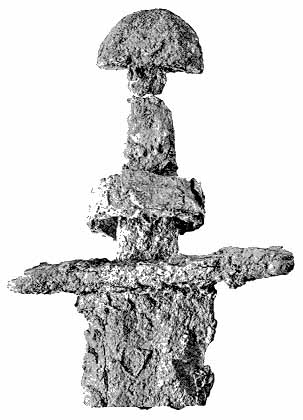
and a third has a wide band:
B 878 Eidnes, Ullensvang, S.B. (fig.127).
The distribution of the swords is as follows: [161]
| Akh. | ||||
| Hedem. | ||||
| Krist. | ||||
| Busk. | ||||
| J.L. | ||||
| Brb. | ||||
| Ned. | ||||
| Stav. | ||||
| S.B. | ||||
| N.B. | ||||
| S.T. | ||||
| N.T. | ||||
| Unknown loc. | ||||
| Total: |
This type is thus quite evenly distributed across the whole country, constituting one of the more common types that show the widest distribution. The earlier variant is not tied to a specific part of the country, it can be found both in Østland and Vestland, it is however, as of yet, not found in Trøndelagen.
Next, we shall look at the various find-combinations for the sake of date determination, and at the same time explore whether there is a noticeable difference in time between the two groups. Unfortunately there are few finds of the first group that offer usable find-combinations. We have found C 1834 ff. from Berg in Løiten, where there are two arrow points, one of which is type A; this one we cannot give consideration here. The other one, however, is of the remarkably slender type with a long shaft and a flat blade, that I believe is precisely from the 900’s or the beginning of the 10th century. The sword’s lower guard is otherwise more of the usual kind. The axe blade is nearest to type I. In another find from Hedemarken C 5386ff. from Bryni, Romedal there are axe blades of a somewhat doubtful kind. In a third find C 19941 ff. from Rør, Ringsaker there are axe blades of type K. Finally we have B 5526 from Opstryn in Stryn, where there are axe blades of a similar type, an arrowhead appearing to be somewhat older, and moreover a shield R 565. All in all, there are, as we shall see, conformity with the main group and we cannot from these find-combinations see any marked difference in the time they appear. It is more according to a typological direction that we hold this to be true.
We have however, much better material for the second group, with the small wide pommel and the low and wide lower guard. The spear points are here usually of type K, with its distinctive characteristics, widest at the lower portion [162] of the blade and with a flattened section on the blade and the upper part of the shaft. In find B 5207 from Nomedal, Hyllestad, there are two spear points (pictured in Gustavson: Norges Oldtid p. 129 fig. 562), with a decorated silver covering. The ornamentation belongs to the latest period of our Viking Age[1].
Noticeably, in one find (B 5405) from Hauge, [163] Gloppen, N.B. we have type I. In another very interesting find (C 18603 from Dal, Romedal, Hed.) we have a spear point of the G type and furthermore a round buckle of the type pictured Ab. 1904 p. 207, fig. 3 [2].
The buckle type is discussed separately l. c. p. 211. All Norwegian finds with buckles of this type have been enumerated, among them also the above mentioned find. The buckle type is dated to the very early Viking Age or to the 7th Period [of the Iron Age]. There is however no reason to doubt the report from find C 18603 and we shall also find this buckle type in the 10th century. The spear point does not point hereto; type G belongs precisely to the 10th century and particularly to the last half. It becomes evident from the discussion of type G that it is not connected with R 519, as it might seem initially.
There are also different varieties of axe blades. The most usual is the thick-necked, blunt, I-type, which seems to be a particularly characteristic shape, found together with swords of type X. Furthermore several specimens of type K appear, as does type L and M. We have an extraordinary specimen of an axe blade in the unquestionably late find C 1292 ff. from Hagerbakken, V. Toten, Krist. The axe blade has here a ledge on the blade but is evidently much younger than the axe blades of type E. However, this last type also appears in two finds from Vestlandet: B 5938 from Sygnesand, Jølster, N.B. and B 6147 from Torblaa, Ulvik, S.B., moreover in a find from Nordland: B 5161, Nes, Hammerø. Finally, there appear a couple of axe blades that make a clear medieval impression. One has already been mentioned previously, C 5386 from Bryni, Romedal, the other is more noteworthy, namely C 10075 ff. from Gipø, Nøterø.
Of the shields, there is only one find that can be considered here, the aforementioned member of the first group: B 5526, Opstryn, Stryn, N.B., where there is a shield of the type R 565. In a presumably double funeral (B 5800, Ytre Arne, Haus, S.B.) there are oval buckles of type R 652. We can moreover note a find from Nordre Virrik, Sandeherred, J.L. (Ab. 1893 p. 93), where there have supposedly been several graves in one mound, but where there among the collected items also were oval buckles as R 652.
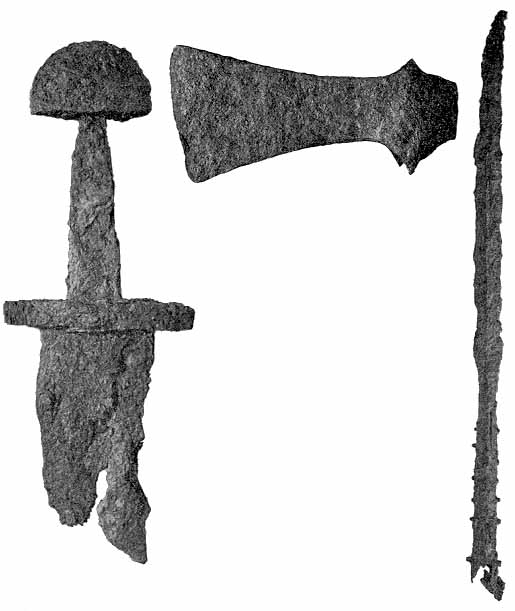
Finally, we shall look at the two finds where the swords should show type X at an older typological stage (fig. 128). In find C 5397 ff. from Vestrum, Hedrum there is an axe blade closest to type K and furthermore a rattle of a later variety. In find B 860-63 from Skeie, Kvinnherred, S.B. (fig. 128) there are spear points of the I-type and furthermore axe blades of the K-type. [164] Both finds belong most likely to the first half of the 10th century. I shall mention that the entire N-type, which at least for some individual specimens can be assumed to have a connection with type X, was dated to the latter part of the 9th century or the beginning of the 10th century.
Furthermore, other [types of] swords are also found together with swords of type X. In the previously mentioned find B 5207 from Nomedal in Hyllestad, there is a sword of type Y; the same is the case in B 878-80 from Eidnes, Ullensvang. In a third find, B 5161 from Nes, Hammerø there is a sword of type O. Finally we have a fourth find in Bergens Museum, also mentioned earlier, B 5800 from Ytre Arne, Haus, S.B., where there is a sword of type P.
According to this [evidence], type X embraces a very extensive time period. It has been a usual statement given by archeologists when they speak of this type, that generally it belonged to the end of the Viking Age [3]. One has evidently thought in terms of the medieval forms, with the long straight guards and a more or less rounded pommel. It is however, not that simple. It is evident that individual swords of the X-type belong among the latest of our swords from the Viking Age; we shall immediately see the evidence of that below. But it is equally evident that the first forms of this type appeared already in the first half of the 10th century. In the first place we heard that in one find there was a spear point of type I. As has been put forward many times previously, this is a type that must be considered to belong to the first half of the 10th century. We heard that this type also was to be found in a find where there were swords of the transitional type leading into type X. When they do not have an unusual development, the axe blades of type E can, even if they are from Vestlandet, not easily be considered as later than the first half of the 10th century. Equally, we shall take note that swords of the O and P type in the same find are considered to belong to the first half of the 10th century. The oval bronze buckles (R 652) must also belong to the same period. These circumstances should be enough to prove that the type appeared during the first half of the 10th century. Equally certain, however, is that it lasted until the very end of the Viking Age. Hereto points first one find as mentioned from Nomedal in Hyllestad, and also a find C 1292 from Hagerbakken, V. Toten, where the sword has that long lower guard. These are without doubt at least from the end of the 10th century, most likely even from the beginning of the 11th [century]. Also the find St. 2589 from Vestly, Lye, Stav. with axe blades of a marked M type, must belong to the last part of the Viking Age. With regards to the additional finds we must believe that these are thought to complete the remaining parts of the 10th century. Based on the available material it is difficult to determine with any more specificity. [165]
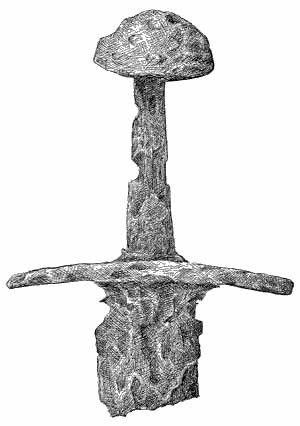
With respect to the actual typological development of the type, it is evident that the taller, slimmer pommels were the early ones, and the small, thick, blunt pommels were the later ones. We hold that, with the smaller, thicker pommels follow the longer lower guards. In particular we shall here note sword C 12217 from Sandeherred (f. 129), where the transition to medieval swords has already begun. Here is the pommel’s under side already begun to become convex [being the earliest stage of evolution towards the brazil-nut pommel].
The two single-edged sword blades in swords of this type are quite extraordinary [4]. Both are from Vestlandet, however, where we have heard that in ancient times there was a stronger tradition of this type of blade. We also heard that there were single-edged blades of type O here. Otherwise the blades were somewhat peculiar, however, slimmer than the single-edged blades from older times. [166]
It is evident that this type was not originally Nordic, even if it of course was forged here at home [Norway]. Besides, it is found in such large quantity, and it is so plain in its form. It exists not only over the whole of Norden [Scandinavia], but also it seems over the whole of Central Europe. It was a common Germanic type in Central and Northern Europe during the couple of centuries preceding the Crusades.
In Sweden I know it from Jämtland, and also Gestrikland [5], likewise Ångermanland (Inv. nr. 5609), Uppland (Inv. - nr. 1034), Birka (Inv. -nr. 957), Dalarne (Inv. -nr. 11097), still two in Uppland in Uppsala museum and finally in Östergötland (Inv. -nr. 7679). Both groups are represented in the Swedish material. Further east we find it also both in Finland and Rusland [Russia] [6], likewise in East-Germany [7], and also in Schlesien[8] from Merschwitz by Breslau, with large pommels on the handle, but otherwise a lower guard of the usual kind. Finally I also know it from Schleswig-Holstein [9], and in the National Museum in Copenhagen, I have at least noted three specimens. It is known also in Switzerland. In Archeological Journal Vol. XXXI p.305 there is a specimen from Canton Bern pictured. The sword is considered purely as a medieval sword (12th century), but is surely a Viking Age sword from the10th or 11th century. On the Bayeux tapestry there seems to be depicted a similar sword [10]. And in England there shall, according to notes by Gustafson, be a specimen in the British Museum, and according to Schetelig two specimen have been found in York [11].
[1] See H. Schetelig: En orientalsk stilindflydelse paa Olaf deb hekkiges tid. Kunst og Kultur b. I p. 48 fig. 10. [return]
[2] Th. Petersen: Fortsatte undersøkelser i Namdalen. II [return]
[3] See for example Hallström i Jämtlands läns fornminnesförenings tidskrift b. 5 h. 3 p. 105 (sword pictured in fig. 7) where he refers the sword to the end of the Viking Age "vikingatidens slut". [return]
[4] One of the swords is from Torblaa, Ulvik (B 6147) pictured in Bergens Museum Aarbok 1908 nr. 3 p. 37 fig. 12). [return]
[5] See fornvännen 1909 p. 297 fig. 78. [return]
[6] Finska fornminnesföreningens tidskrift VI p. 80 og Aspelin: Antiquités p. 272 nr. 1359 og 1363, p. 317 nr. 1724. [return]
[7] Praehistorische Zeitschrift II p. 72 fig. 3 (H. Busse: Ein eisenes Langschwert), where it is considered a slavic form, something we according to remaining materials have no reason to assume. [return]
[8] Schlesiens Vorziet in Schrift und Bild N. F. III p. 189. [return]
[9] J. Mestorf: Vorgeschichtliche Altertümer aus Schleswig-Holstein Taf. LVII fig. 705. [return]
[10] See Viollet-le-Duc: Dictionnaire du Mobilier Français t. 5 p. 366. [return]
[11] See also Archaeological Journal VIII p. 425. [return]